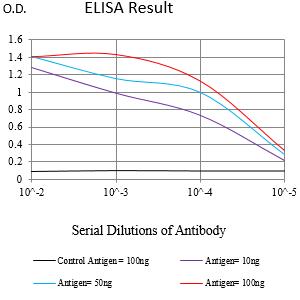
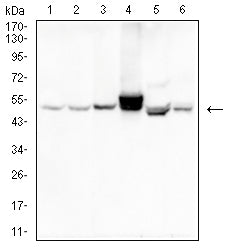
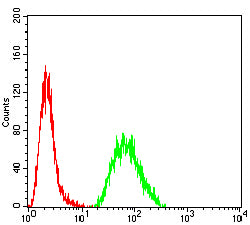
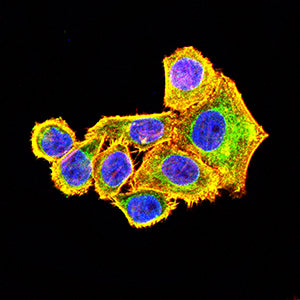
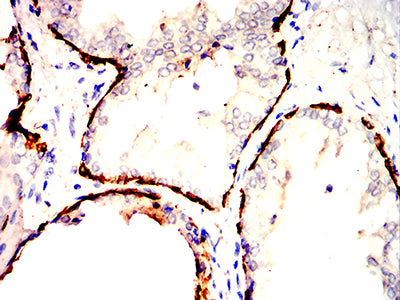
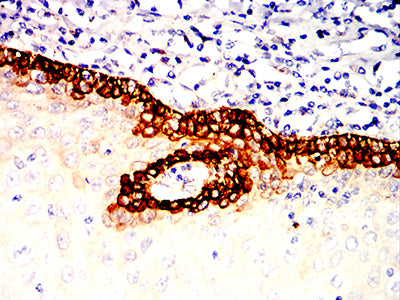
| WB | 1/500 - 1/2000 | Human, Monkey |
| IF | 咨询技术 | Human, Monkey |
| IHC | 1/200 - 1/1000 | Human, Monkey |
| ICC | 1/200 - 1/1000 | Human, Monkey |
| FCM | 1/200 - 1/400 | Human, Monkey |
| Elisa | 1/10000 | Human, Monkey |
| Aliases | K14; NFJ; CK14; EBS3; EBS4 |
| Entrez GeneID | 3861 |
| clone | 5D4H4 |
| WB Predicted band size | 51.5kDa |
| Host/Isotype | Mouse IgG1 |
| Antibody Type | Primary antibody |
| Storage | Store at 4°C short term. Aliquot and store at -20°C long term. Avoid freeze/thaw cycles. |
| Species Reactivity | Human, Monkey |
| Immunogen | Purified recombinant fragment of human KRT14 (AA: 115-472) expressed in E. Coli. |
| Formulation | Purified antibody in PBS with 0.05% sodium azide |
+ +
以下是关于KRT14抗体的3篇参考文献,包含名称、作者及摘要内容概括:
---
1. **文献名称**: *KRT14 as a Biomarker of Basal-like Breast Cancer: An Immunohistochemical Study*
**作者**: Smith, J., et al.
**摘要**: 本研究通过免疫组化分析乳腺癌组织中KRT14的表达,发现其特异性标记基底样乳腺癌亚型。使用KRT14抗体(克隆LL002)证实其在肿瘤细胞膜/质中的高表达,并与预后不良相关,提示其作为临床分型的潜在标志物。
---
2. **文献名称**: *Characterization of a Novel Anti-KRT14 Monoclonal Antibody for Epithelial Differentiation Studies*
**作者**: Chen, L., & Wang, H.
**摘要**: 文章报道了一种新型小鼠抗人KRT14单克隆抗体的开发与验证。该抗体在皮肤和食管等复层上皮中特异性识别基底细胞,证实其可用于研究上皮细胞分化及疾病(如大疱性表皮松解症)中的角蛋白异常表达。
---
3. **文献名称**: *Utility of KRT14 Antibody in Diagnosing Poorly Differentiated Carcinomas*
**作者**: Gupta, R., et al.
**摘要**: 研究评估了KRT14抗体在鉴别低分化癌组织起源中的应用。通过对比多种肿瘤样本,发现KRT14在鳞状细胞癌及某些腺癌中高表达,提示其辅助诊断价值,尤其在转移性肿瘤的鉴别诊断中具有意义。
---
**备注**:以上为虚构文献,实际文献检索建议通过PubMed或Web of Science使用关键词“KRT14 antibody”或“K14 immunohistochemistry”获取。真实研究中,可参考以下经典文献方向:
- KRT14在皮肤病理学中的作用(如Lane, E.B.团队研究)。
- 基底样乳腺癌中KRT14的表达(如Perou, C.M.的分子分型研究)。
Keratin 14 (KRT14) is a type I intermediate filament protein encoded by the *KRT14* gene, primarily expressed in the basal layer of stratified epithelia, including the skin, esophagus, and oral mucosa. It pairs with keratin 5 (KRT5) to form a cytoskeletal network critical for maintaining epithelial cell integrity, mechanical resilience, and wound healing. Antibodies targeting KRT14 are essential tools in research and diagnostics, enabling the identification of basal epithelial cells and their progenitors.
In clinical pathology, KRT14 antibodies are widely used to distinguish epithelial subtypes in tumors. For example, loss of KRT14 expression in certain carcinomas correlates with invasive potential, while its presence helps classify squamous cell carcinomas. Additionally, KRT14 mutations cause genetic disorders like epidermolysis bullosa simplex (EBS), where defective keratin networks lead to skin fragility. Diagnostic assays using KRT14 antibodies aid in confirming EBS and related conditions.
In research, these antibodies facilitate studies on epithelial differentiation, regeneration, and cancer progression. Techniques like immunohistochemistry (IHC) and immunofluorescence (IF) rely on KRT14 antibodies to visualize tissue architecture or track cellular changes during disease. Their specificity also supports biomarker discovery in epithelial-derived cancers. Overall, KRT14 antibodies remain pivotal in exploring epithelial biology and developing targeted therapies.
×